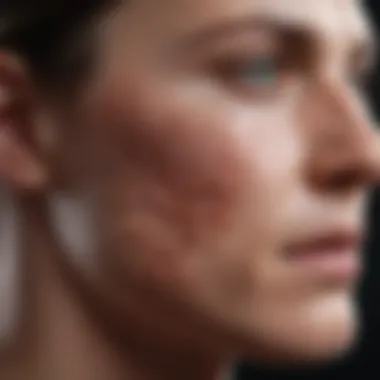Bile Salts and Itchy Skin: Exploring the Connection


Intro
The relationship between bile salts and itchy skin constitutes a vexing topic in dermatological research. Bile salts, known for their role in digestion, also show potential links to skin health and discomfort. As liver function directly impacts bile production, any dysfunction can lead to an accumulation of bile acids in the bloodstream, possibly resulting in skin irritation. This article aims to unravel these complexities, shedding light on how bile salts may influence dermatological conditions, specifically itching.
Understanding this interaction is essential for students, researchers, and professionals interested in the intricate connections within human physiology.
Research Overview
Summary of key findings
Current research indicates that elevated bile salts in the circulation may lead to a sensory response manifested as itching. This phenomena, often encountered in patients with liver disease, suggests that bile acids may activate certain neural pathways involved in the perception of itch. Studies have shown that bile salts can induce itching independently of other known pruritogens, emphasizing the need to focus on liver health when assessing skin conditions.
Importance of the research in its respective field
Understanding the effects of bile salts is crucial due to the increasing prevalence of liver diseases worldwide. The connection between bile salts and dermatological outcomes can have significant implications for treatment strategies. As researchers continue to explore this relationship, more informed interventions may evolve, enhancing patient care in both liver and skin health.
Methodology
Description of the experimental or analytical methods used
Research studies typically involve both clinical and laboratory approaches. Clinical studies often assess patients with liver dysfunction and document skin responses through scoring systems for pruritus. Laboratory methods may include measuring bile salt concentrations in serum and evaluating their effects on sensory neurons in vitro.
Sampling criteria and data collection techniques
Recruitment usually targets individuals with diagnosed liver conditions, ensuring a robust comparison with healthy control groups. Data is collected through surveys, clinical examinations, and biochemical analyses, which provide insights into the physiological interplay between bile salts and itching.
"The exploration of bile salts extends beyond mere digestion; it intersects fundamentally with integumentary physiology and overall well-being."
The findings gleaned from these studies are pivotal for advancing understanding of these biochemicals, and they underscore the importance of integrated healthcare approaches.
By synthesizing the data, this investigation aims to present a thorough narrative on how bile salts influence dermatological phenomena, supporting a holistic view of health.
Prelude to Bile Salts
Bile salts play a crucial role in human physiology, particularly in digestion and metabolism. Understanding bile salts is essential for grasping their potential impact on skin health, especially in cases of itching. This section outlines the definition, production process, and functions of bile salts, providing the foundation for later discussions on their connection to dermatological conditions.
Definition and Composition
Bile salts are steroid acids derived from cholesterol, synthesized in the liver. They are primarily composed of bile acids, which are conjugated with amino acids like glycine or taurine, enhancing their solubility. Bile salts can be classified into two main categories: primary and secondary. Primary bile salts, such as cholic acid and chenodeoxycholic acid, are produced directly in the liver. In contrast, secondary bile salts, formed by gut bacteria via dehydroxylation, include deoxycholic and lithocholic acids. This composition is critical for understanding how bile salts aid in lipid digestion and absorption.
Bile Production Process
The production of bile is a complex process initiated in the liver. Hepatocytes, the liver's functional cells, convert cholesterol into bile acids through several steps, primarily during the synthesis phase. Once formed, bile acids are transported to the gallbladder, where they are stored and concentrated. Upon eating a meal, especially one high in fats, the gallbladder contracts, releasing bile into the small intestine. This release is vital for emulsifying fats and promoting the absorption of fat-soluble vitamins (A, D, E, K). The entire process regulates digestion and metabolism effectively, illustrating the importance of bile salts in the body.
Functions of Bile Salts in Digestion
Bile salts serve primarily to aid in the digestion and absorption of dietary fats. Their amphipathic nature allows them to emulsify lipids, breaking them down into smaller particles. This emulsification increases the surface area for pancreatic lipases to act upon, enhancing fat digestion. Moreover, bile salts promote the formation of micelles, structures that facilitate the transport of lipids and fat-soluble vitamins across the intestinal epithelium into the bloodstream.
In addition to their digestive roles, bile salts are also involved in signaling pathways that regulate cholesterol homeostasis and glucose metabolism. These functions underscore the multifaceted role of bile salts beyond simple digestion, marking them as significant players in overall metabolic processes.
"Understanding the role of bile salts is critical for exploring their potential effects on dermatological conditions, particularly itchy skin related to liver function."
Bile salts are fundamental to digestion and bodily processes. Their production and function highlight their significance in bodily health, making it essential to explore their intricate links to skin health later in this article.
Itchy Skin: An Overview


Itchy skin, or pruritus, is a common and often distressing condition affecting a wide range of individuals. Its significance in this article lies in understanding its potential relationship with bile salts and liver health. It serves as a foundation for exploring how bile salt dysregulation can manifest not only in digestive disorders but also in dermatological symptoms like itching. The need to grasp the nuances of itchy skin arises from its multifaceted nature and varying causes. By thoroughly examining this topic, readers will appreciate the broader implications it has on overall well-being and the interconnectedness of bodily systems.
Common Causes of Itchy Skin
- Allergic Reactions: Allergens such as pollen, pet dander, and certain foods can trigger immune responses, leading to itching.
- Dermatological Conditions: Skin diseases including eczema, psoriasis, and dermatitis often present with pruritus as a key symptom.
- Infectious Agents: Fungal infections, like athlete's foot, or parasitic infestations, can contribute to itchiness.
- Systemic Diseases: Conditions such as diabetes or kidney disease can elicit itching as a secondary symptom.
- Liver Dysfunction: Impaired liver function may lead to abnormal bile salt levels, resulting in skin irritation.
It is crucial to pinpoint the specific cause of itching to address it effectively. More often, an interdisciplinary approach is necessary, considering both skin and internal health.
Pathophysiology of Itching
The sensation of itch arises from a complex interaction between the skin's nerve endings and various biological signals.
- Nerve Fibers: Specialized nerve fibers respond to pruritic stimuli. These fibers transmit itch signals to the central nervous system, triggering responses that can lead to scratching.
- Inflammatory Mediators: Substances like histamines and cytokines play a pivotal role in modulating itch. They are released in response to allergens or irritants, contributing significantly to itching sensations.
- Psychological Factors: Stress and anxiety might amplify feelings of pruritus, creating a cycle of itching and emotional discomfort.
Understanding these mechanisms is vital. It provides insights into why treatments for itchy skin can be complex and why managing underlying conditions, such as liver issues, is equally important to alleviate symptoms.
"Addressing the root causes of pruritus is essential for effective management, particularly in cases that stem from underlying health issues."
By uncovering the different facets of itching, we can better appreciate its relationship with bile salts and, consequently, liver health.
The Link Between Bile Salts and Itching
Understanding the connection between bile salts and itching is essential for comprehending various dermatological conditions. Bile salts play a significant role in digestion but their implications extend to skin health. This relationship is particularly relevant for conditions such as cholestasis, where bile salts accumulate in the bloodstream due to liver dysfunction. The itching experienced during this condition is not just a surface issue but indicates deeper physiological disturbances. It is common for patients suffering from liver diseases to report severe itching, which can significantly affect their quality of life. Thus, exploring this link helps in recognizing symptoms and directs attention towards better diagnostic and therapeutic strategies.
Understanding Cholestasis and Its Effects
Cholestasis is a condition that occurs when bile cannot flow from the liver to the duodenum. This blockage can happen in the intrahepatic or extrahepatic bile ducts. Intrahepatic cholestasis often results from liver diseases such as hepatitis or cirrhosis, where damaged liver cells contribute to bile acid accumulation. Conversely, extrahepatic cholestasis may be due to gallstones or tumors obstructing the bile ducts.
When bile salts build-up in the bloodstream, they may lead to various symptoms. One of the most distressing is pruritus, commonly known as itching. Itching often affects areas like the palms and soles but can spread over the entire body. The precise mechanism behind this itch is complex, involving changes in skin sensitivity and the nervous system's response to elevated bile acids. The accumulation of bile acids can lead to an increase in endogenous opioids in the skin, which influences itch sensation.
Key effects of cholestasis include:
- Increased bile acid levels in the blood
- Skin irritation and potential rashes
- Long-term skin damage if not addressed
Bile Acids and Pruritus
Bile acids directly influence the sensation of itching in cholestatic conditions. Research indicates that bile acids can activate pruritus-related neurons. This can lead to an inappropriate response from sensory receptors in the skin, resulting in an uncomfortable itch that is often difficult to manage.
In healthier individuals, bile acids aid in digestion and fat absorption. However, when these acids are in excess, as seen in cholestasis, they may act as irritants. The histamine release and activation of the nociceptors contribute to the sensation of pruritus.
Furthermore, other factors associated with liver dysfunction could exacerbate the itching. For instance, hormone changes and immune response alterations can also play roles, making it critical to consider the whole patient rather than just the bile acids alone.
In summary, the interplay between bile salts and pruritus is intricate. Understanding how bile acids affect skin could lead to more targeted treatments for those suffering from cholestatic itching. While scratching may feel like a temporary relief, it can worsen skin damage and lead to infections. Thus, identifying and managing the underlying causes is crucial for alleviating symptoms.
Bile Salts in Liver Disease
Bile salts play a crucial role in the digestive system, particularly in the context of liver health. They assist in the digestion and absorption of fats and fat-soluble vitamins. When the liver malfunctions, the production of bile salts is often negatively impacted, leading to various metabolic issues. Investigating bile salts in liver disease helps to understand how impaired liver function can result in a host of symptoms, including but not limited to, itchy skin.
Hepatic Disorders and Bile Salt Production
Hepatic disorders refer to a broad spectrum of liver diseases, including Cirrhosis, Hepatitis, and Non-Alcoholic Fatty Liver Disease (NAFLD). Each condition can drastically alter the liver's ability to produce bile salts effectively.
- Cirrhosis: In cirrhosis, the liver becomes severely scarred, leading to a reduction in bile salt production. This decrease can result in an imbalance in bile acid synthesis, causing further complications.
- Hepatitis: Hepatitis, whether viral or autoimmune, inflames the liver and can also inhibit bile salt production. Patients with hepatitis may experience disruptions in digestion and other systemic effects.
- Non-Alcoholic Fatty Liver Disease (NAFLD): This condition is increasingly prevalent and often leads to liver inflammation. Even in early stages, NAFLD may affect bile salt synthesis, further complicating the symptomatic presentation of patients.
Understanding these hepatic disorders sheds light on the underlying mechanisms, which might lead to the accumulation of bile salts in the body.


Bile Salt Accumulation and Skin Symptoms
When bile salts accumulate due to liver dysfunction, they can exert significant effects on various organ systems, particularly the skin.
- Pruritus: One of the most challenging symptoms from bile salt accumulation is pruritus, or itching. Patients often describe intense itching that is not necessarily connected to any visible skin condition.
- Xanthomas: Another potential skin manifestation is the development of xanthomas, which are deposits of cholesterol that can appear as yellowish plaques on the skin.
Thus, it is evident that for individuals with liver disease, careful monitoring of bile salt levels is essential.
Diagnosis of Bile Salt-Related Itchy Skin
Diagnosing bile salt-related itchy skin requires an understanding of both liver function and the specific tests used to identify conditions contributing to pruritus. It is crucial because skin itching can result from various underlying issues, particularly those related to liver health. Early and accurate diagnosis can pave the way for effective treatment plans, significantly improving the quality of life for affected individuals.
Assessing Liver Function
Liver function assessment is a fundamental step in diagnosing bile salt-related itching. The liver plays a key role in bile production and regulation, which are vital for digestion andexcretion of waste products. Blood tests are commonly employed to evaluate liver function, focusing on several important liver enzymes and other related markers.
- Alanine aminotransferase (ALT) and aspartate aminotransferase (AST) levels are indicators of liver cell damage. Elevated levels suggest potential liver injury or disease.
- Alkaline phosphatase (ALP) can reveal bile duct obstructions. It is significant for understanding cholestasis, a condition where bile flow is impaired.
- Bilirubin levels provide further insights into liver function. High levels may indicate a problem with bile salts or liver failure.
These tests help distinguish between various liver pathologies, thus facilitating the diagnosis of the condition. Individuals experiencing persistent itchy skin should undergo these assessments as early intervention can prevent further complications.
Diagnostic Tests for Pruritus
In addition to evaluating liver function, specific diagnostic tests are necessary to understand the cause of pruritus. These tests often include:
- Skin biopsies: To assess for dermatological conditions, inflammation, or other skin disorders.
- Serum bile acids: A test that specifically measures bile salt levels in the bloodstream, indicating cholestasis or liver dysfunction.
- Imaging studies: Ultrasound or MRI scans can be utilized to visualize liver structure and identify abnormalities such as tumors or bile duct obstructions.
These diagnostic approaches, when combined, can provide a comprehensive picture of the individual's health status. Proper diagnosis is vital in crafting effective management strategies and addressing the root cause of bile salt-related itchy skin.
By accurately diagnosing the issue, one can focus treatment on restoring liver function or alleviating skin symptoms effectively.
In summary, the diagnosis of bile salt-related itchy skin combines evaluating liver health through several tests along with specific assessments geared towards understanding the nature of the pruritus. Proper diagnosis not only allows for effective treatment plans but also reassures patients regarding their condition.
Treatment Options for Itchy Skin Related to Bile Salts
Itchy skin, often associated with various conditions, can be particularly challenging when linked to bile salts. Understanding appropriate treatment options allows for better management of symptoms. This section discusses common therapies and lifestyle modifications that can alleviate itching and enhance skin health.
Medications and Therapies
Medications play a vital role in addressing itchy skin related to bile salts. Here are some key treatment strategies:
- Antihistamines: These medications can help reduce itching. Cetirizine and loratadine are two commonly used options. They work by blocking histamine receptors, which alleviates itchiness and helps with associated discomfort.
- Topical Corticosteroids: Creams like hydrocortisone can reduce inflammation when applied directly to the skin. They are effective for managing localized itching and irritation.
- Ursodeoxycholic Acid: This bile acid is sometimes used in cases of cholestasis. It may help improve bile salt flow and consequently decrease itching. Studies support its utility in patients with liver diseases characterized by bile accumulation.
- Phototherapy: Ultraviolet light therapy is another option. Controlled exposure to UV light can lessen pruritus for some individuals. However, it needs to be conducted under medical supervision to avoid skin damage.
Each therapy has unique benefits and considerations. Consulting with a healthcare provider is essential to determine the best approach.
Lifestyle Modifications
Lifestyle choices can significantly affect the severity of itching associated with bile salts. Here are practical strategies to consider:
- Hydration: Regularly moisturizing the skin helps maintain its barrier function. Using emollients like CeraVe or Aquaphor can provide relief from dryness and itching.
- Avoiding Irritants: Identify and minimize exposure to harsh soaps, perfumes, or other irritants. Gentle, fragrance-free products are generally more suitable for sensitive skin.
- Dietary Changes: Incorporate foods rich in omega-3 fatty acids. Diet can influence skin health. Fatty fish or flaxseeds may aid in reducing inflammation and improving skin condition.
- Stress Management: Reducing stress through yoga, meditation, or other relaxation techniques can also help. Emotional stress can exacerbate skin conditions and itching.
By implementing these modifications, many individuals can find significant relief from itchy skin.
"An integrated approach combining medications and lifestyle changes can enhance the quality of life for individuals dealing with itchiness caused by bile salts."
Understanding the synergy between therapeutic options and lifestyle adjustments is key to effectively managing this condition.


Research Advances in Bile Salts and Dermatology
Research into bile salts has gained traction in the field of dermatology, particularly regarding their substantial role in skin health. The intersection of hepatology and dermatology reveals how disturbances in bile salt metabolism can result in various skin conditions, including persistent itching, medically termed pruritus. By understanding these relationships, researchers aim to develop better diagnostic tools and therapeutic strategies to address these skin issues effectively.
Current Studies and Findings
Recent studies have shed light on the mechanisms by which bile salts influence skin health. Notably, specific research indicates that high levels of certain bile acids correlate with pruritus in patients suffering from liver diseases. This is especially evident in conditions like cholestasis, where there is a reduced flow of bile from the liver, leading to bile salt accumulation. Studies demonstrate alterations in the skin barrier function and increased nerve sensitivity in these patients, further underpinning the relationship between bile metabolism and dermatological health.
Furthermore, findings from clinical trials are beginning to explore the efficacy of various medications used to alleviate itching. This includes bile acid sequestrants, which have shown promise in reducing the levels of bile acids in circulation, potentially ameliorating associated itching.
"Current research highlights a significant connection between liver function and skin integrity, emphasizing the need for integrated health approaches."
Future Directions in Research
The future of research into bile salts and dermatology appears promising. One area of interest focuses on the molecular pathways through which bile acids might induce itching. Better understanding of these pathways could lead to targeted therapies that alleviate pruritus without major side effects.
Moreover, as the field of microbiome research continues to expand, the impact of gut microbiota on bile salt production and metabolism is an emerging front. Investigations into how gut health influences bile acids and resulting skin conditions may open new avenues for treatment.
Finally, there is a growing need for longitudinal studies that track changes in bile salt composition and skin health over time. Through comprehensive data gathering, researchers can draw more robust correlations, paving the way for advanced therapeutic interventions.
Practical Management Strategies
Understanding practical management strategies for addressing itchy skin associated with bile salts is crucial. These strategies aim to optimize patient care and enhance overall comfort. They encompass various integrative approaches and education methods to empower patients and healthcare providers.
Integrative Approaches
Integrative approaches involve combining conventional medical treatments with supportive therapies to form a comprehensive care plan. This may include:
- Nutritional Support: Focusing on a balanced diet rich in vitamins and minerals can improve liver function and overall skin health. Foods high in fiber can also assist in bile salt regulation.
- Herbal Remedies: Some herbs, like milk thistle, might promote liver health. However, it is crucial to consult a healthcare professional before starting any herbal regimen.
- Physical Therapies: Techniques like acupuncture or yoga may help alleviate stress, which can indirectly reduce itchiness.
These approaches not only aim to reduce symptoms but also support long-term health goals. Each individual may require a tailored plan based on their specific needs and health status.
Patient Education and Support
Patient education plays an imperative role in managing itchy skin related to bile salts. Educating patients about their condition can lead to better self-management and greater compliance with treatment plans. Important elements include:
- Understanding Symptoms: Patients should be informed about the connection between liver health and skin itchiness. Recognizing early signs can lead to timely intervention.
- Lifestyle Guidance: Providing advice on lifestyle changes, such as maintaining hydration and avoiding irritants, can greatly impact skin health.
- Support Networks: Encouraging patients to connect with support groups can foster a sense of community and shared experiences. This can be beneficial for emotional well-being.
"Empowering patients through knowledge can significantly improve their quality of life and treatment outcomes."
Ending: Bile Salts and Skin Health
The exploration of the relationship between bile salts and skin health reveals intricate connections that extend beyond basic physiology. This conclusion seeks to encapsulate the relevance of bile salts in dermatological conditions, particularly in explaining itchiness. Understanding how bile salts function within the body, particularly in liver health, is essential for comprehending their impact on skin conditions. Furthermore, recognizing the multifaceted nature of these interactions can aid healthcare professionals in diagnosing and treating conditions related to bile salt imbalances.
This article has established the crucial link between bile salts and itching by discussing their origin, function in digestion, and their role in liver disease. The research indicates that when bile salts accumulate due to liver dysfunction, they can lead to a range of dermatological symptoms, including pruritus. Hence, the effects of bile salts are not just limited to digestion but also extend to skin health, which can significantly affect a person's quality of life.
"Bile acids serve not only as digestive agents but also influence dermatological health, emphasizing the detailed connections within our bodily systems."
An understanding of these dynamics equips both patients and healthcare providers with the knowledge to address skin symptoms linked with bile salt issues thoughtfully and effectively. As research continues, the insights drawn from these findings can guide tailored approaches in managing related health issues.
Summary of Findings
In summary, the comprehensive exploration has illuminated several key elements regarding bile salts and their relevance to skin health:
- Bile Salts and Liver Function: The production and regulation of bile salts are closely tied to liver health. Conditions such as cholestasis directly affect bile salt levels, leading to potential skin irritations.
- Pruritus Mechanism: Bile acids can trigger itching by impacting nerve endings and skin cells, elucidating why liver disorders frequently correlate with intense itching sensations.
- Treatment Implications: Current treatment options include medications that regulate bile salt levels. Lifestyle modifications can also play a crucial role in managing symptoms.
The integration of these findings into clinical practice could improve patient outcomes, highlighting the need for further engagement in the area of bile salt research.
Implications for Future Studies
The implications of current findings surrounding bile salts and skin health are profound and warrant further investigation. Future studies should focus on:
- Pathophysiological Mechanisms: Detailed exploration of how bile salts influence the skin at a cellular and molecular level remains necessary. Improved comprehension could lead to novel therapeutic strategies.
- Longitudinal Studies: Conducting long-term studies to track the impact of bile salt levels on skin health will help ascertain causality and better inform treatment pathways.
- Interdisciplinary Approaches: Collaboration between hepatologists and dermatologists can enhance the understanding of interconnected systems, fostering holistic management strategies for patients.
- Patient-Centric Research: Engaging with patients to understand their experiences can spark research that addresses real-world issues associated with bile salts and itching.







